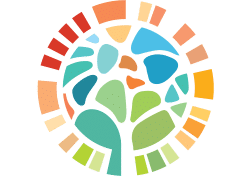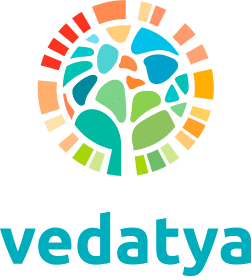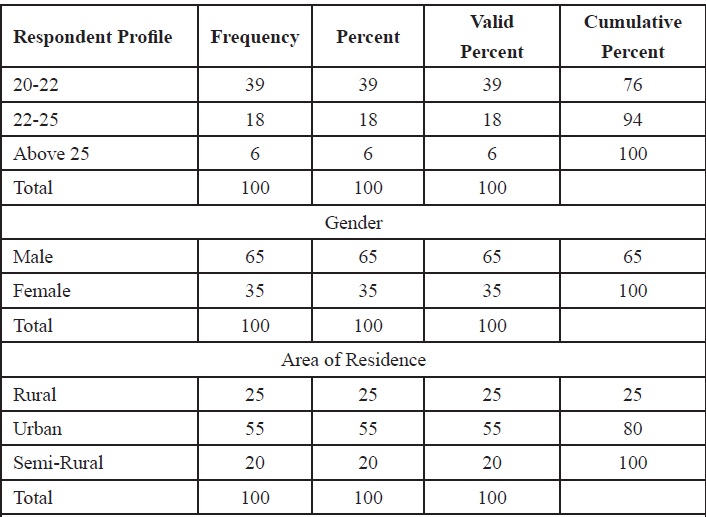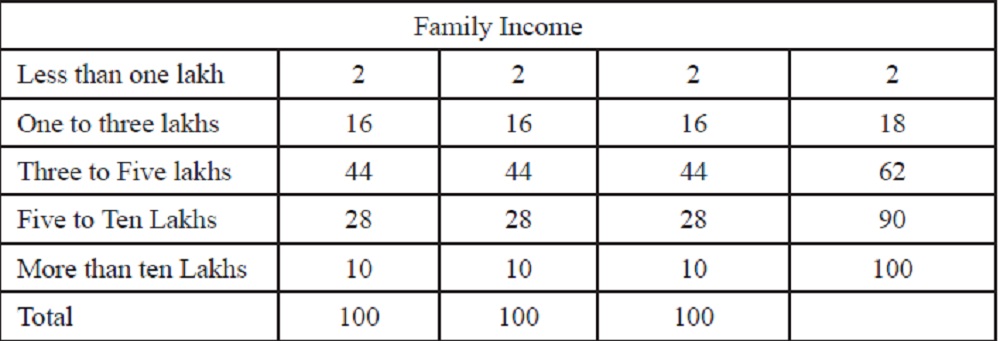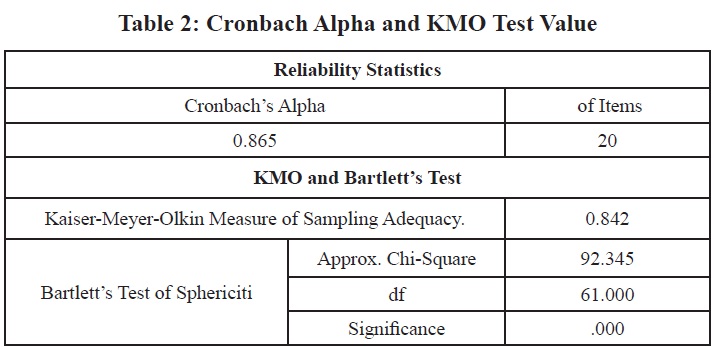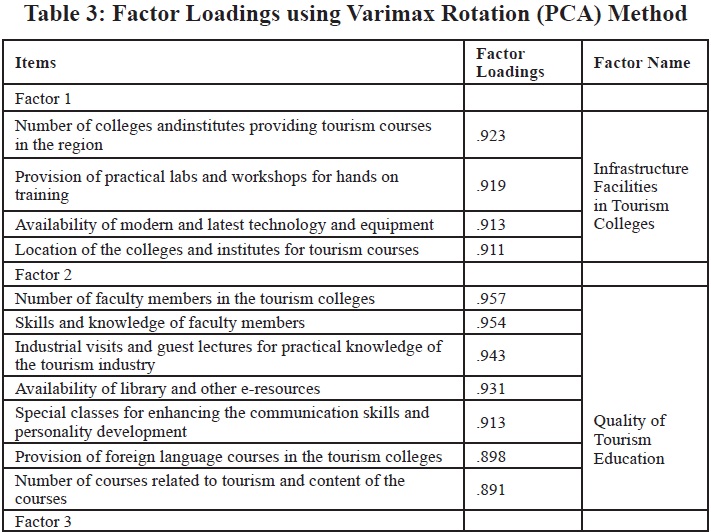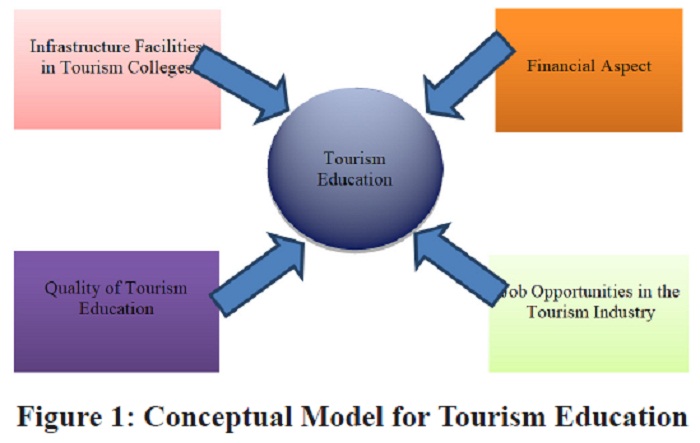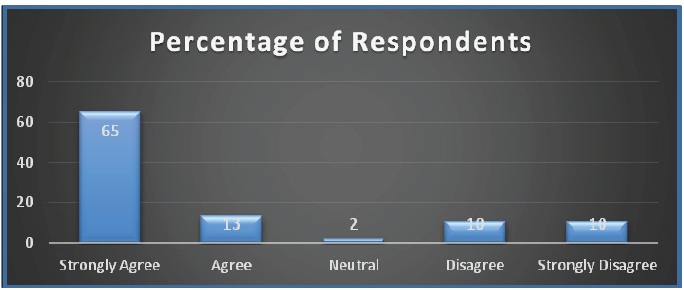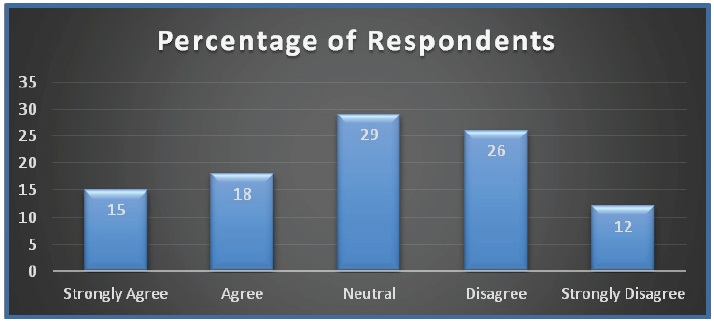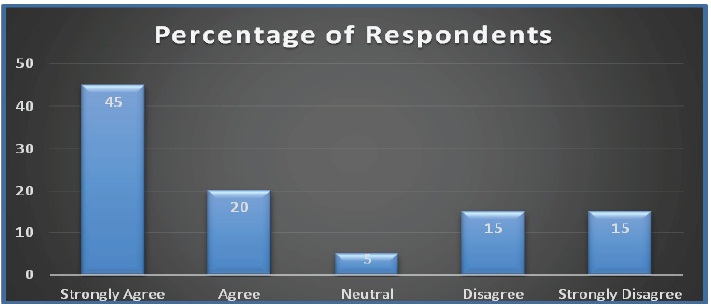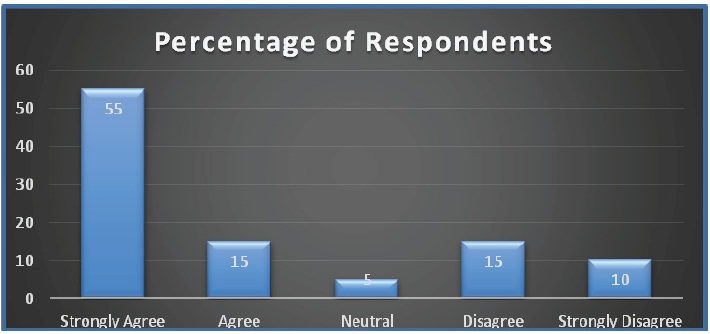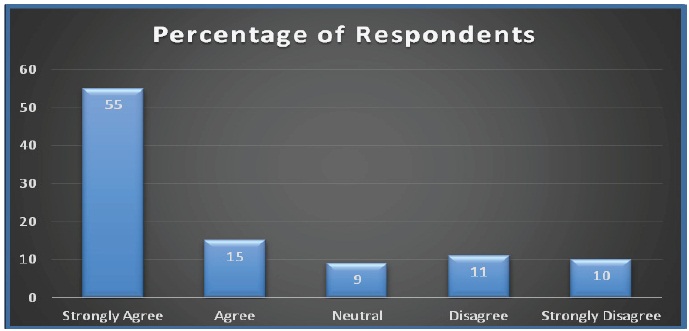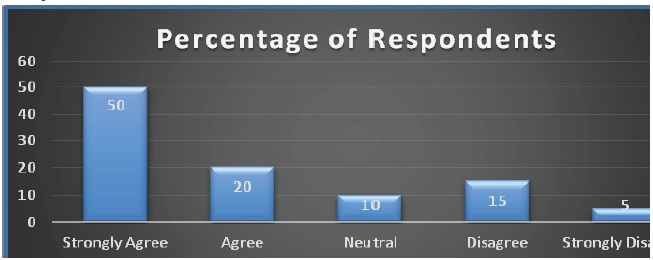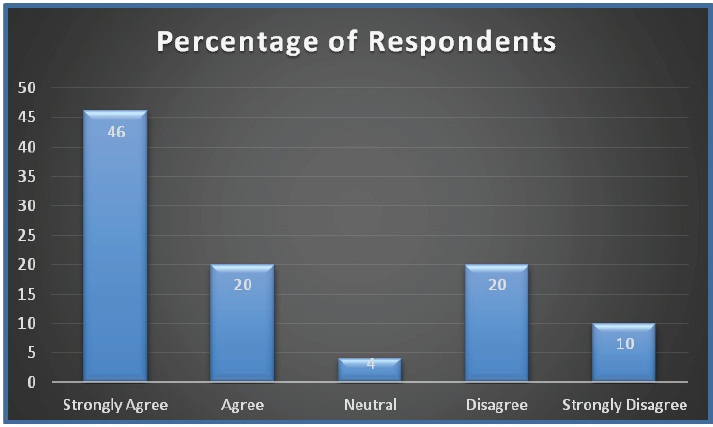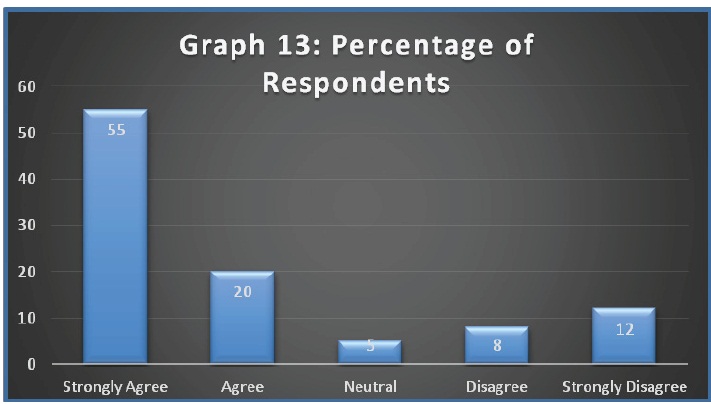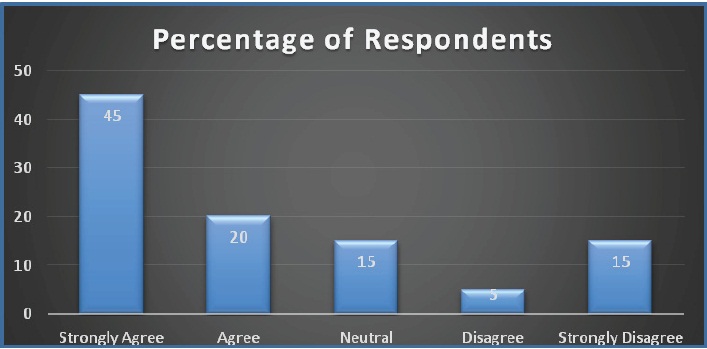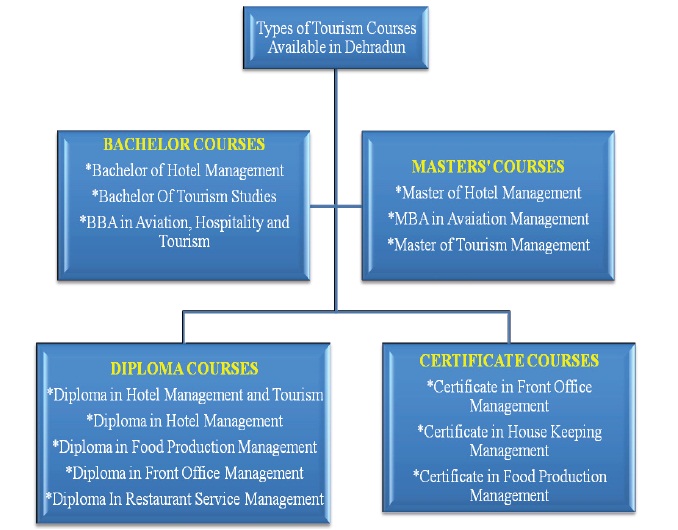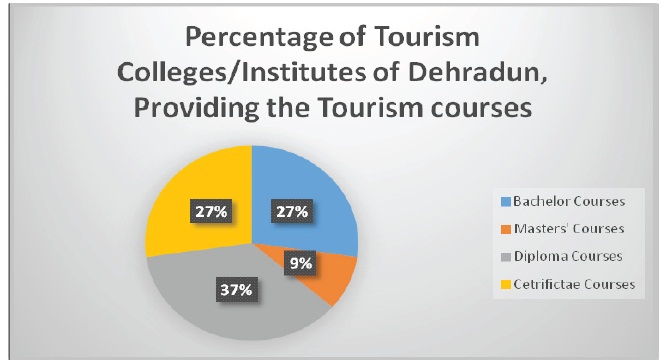Tourism Education In Dehradun – A Study Of The Stature Of Tourism Colleges In Dehradun
Tourism in India is a booming industry. Tourism contributes 6.23 percent to the national GDP and 8.78% of the total employment in India. Now a day’s Tourism industry & education are the prime concerns of most of the developed nations in the world. The city Dehradun is the capital of Uttarakhand state of India. It is one of the most popular tourist destinations across India, known for its scenic surroundings and beautiful mountain tracks. The purpose of the study is to find out the stature of tourism education in the city. The study will analyze the market to find out the status of the tourism education at UG and PG level. Study helps to find out the role of tourism education in a tourism rich state and how professionalism in education enhances the quality.
INTRODUCTION
Tourism in India is a booming industry. Tourism contributes 6.23% to the national GDP and 8.78% of the total employment in India. The Foreign Tourist Arrivals (FTAs) in India during 2015 were 6.58 million, contributing anestimated foreign exchange earnings of US$ 14.19 billion. Despite the recession, the tourism industry has shown impressive growth in the number of foreign tourist arrivals. India is 42nd in the world rankings as per foreign tourism arrivals in the globe. The World Travel and Tourism Council (WTTC) has named India along with China, as one of the fastest growing tourism industries for the next 10 to 15 years. Tourism today is the most vibrant tertiary sectors and has a dominant stronghold in the economy.
Indian tourism is vast & varied, it requires professionally trained manpower to develop, promote, plan & market to deliver high quality services in the global competitive market. Nowadays the tourism industry & correspondent education are the prime concerns of most of the developed nations in the world. Developing nations & least developed countries also try to project their tourism in the current knowledge based society. Therefore, quality education, industry institute partnerships, collaboration with consultants, rethinking of vocational education, impetus on higher education, research & training in the field have to be focused upon to ensure the smooth functioning of tourism industry. International organizations like the World Travel & Tourism Council (WTTC), the World Tourism Organization (WTO), the World Leisure & Recreation Association (WLRA) have realized the importance of tourism in job creation & the benefit to emerging & developed nations.
Tourism is a major social and economic phenomenon in a country like India with enormous economic implications. It is an important instrument for peace and harmony, socio-economic development, entrepreneurship and employment. Tourism experts from both developed & developing countries have appropriately acknowledged the dynamics of tourism education. Britton (1982); Mathieson and Wall(1982); Richter (1989); Bagus (1992); Nuryanti (1992) and Hall (1994). The success of tourism seriously depends upon effective efficient trained manpower. Proper training & education can only help to create real professionals in tourism in the economy.
In the wake of globalization and economic restructuring, different countries of the globe are trying to redefine and rebuild the economy; particularly so after the recent economic disaster. Though tourism is a very sensitive and vulnerable industry, it is immediately affected by disasters, unrest, terrorism and economic recession. The tourism industry offers employment to both trained and untrained, skilled & semi-skilled people. Hence, this sector is very important for real growth of any country.
The panacea for developing the desired skills for service delivery, through educating manpower in a formal way has gained significance lately, and the same is been stressed upon by the think tanks from academicians to industry stakeholders. The result of this exercise has taken its shape in terms of offering a Diploma Programme in Tourism in 1970’s, and slowly it has gained significance through the acceptance and popularity from the industry. Slowly, many universities have come forward to offer tourism courses at the Diploma and PG Diploma levels. The success of the course has motivated almost 20 -25 Universities across the vast sub-continent, to offer tourism courses at varying levels. The Government of India under its Tourism Ministry wing has constituted an autonomous Indian Institute of Tourism & Travel Management (IITTM) in Gwalior, during the 1980’s. Now many private colleges and Universities (Deemed) are also in the race of offering tourism related course to meet the industry demand for skilled professionals.
Tourism Education – The Past, Present and the Future
Tourism education is viewed as the driving force in developing tourism for any country and hence, it is given high momentum by the developing countries. However,most of the developing countries could not create a conducive environment for tourism education. It is often perceived that tourism education is almost based on an international perspective. Many experts view tourism education aligned to the loca l perspective, which ensures the local development of the region and community Burkart and Medlik(1974); Tribe ( 1997) & Bergsma ( 2000). It is very difficult to differentiate between the past and present scenarios,as India started offering tourism courses only in the recent 3 decades. The past of tourism education, used to be vocational in nature. There were no degree and higher level of education in this field, as only Diploma and PG Diploma courses were offered.
The commonly raised confusion regarding the curriculum include questions like, what should be the content of the modules, does any literature exist to frame the necessary modules, from where does this knowledge arise, what is the guiding way and stepping stone etc. It is almost known as a professional course and sufficient development has arrived and ended at a space of interdisciplinary approach, getting varied subjects from various courses and still it is found to be multidisciplinary in nature Bagri) 2007. The next assignment for the academicians was, to identify the modules and subjects for various programs at different levels of instruction. Subjects from management, commerce, finance, history, geography, geology, and economics have been borrowed to frame the course curriculum as per industry expectations, in alignment with vocational content Kukreti (2007) & Bansal (2006). With the development of these interdisciplinary modules in tourism education, it has expanded its wings to mold the students in varied aspects. The industry has also developed and expanded in many ways. Incidentally, there is a notion that the courses offered by the Universities do not comply with the expectations of the industry, thus being considered as a limitation in context of the present curriculum Bharadwaj et al. (2006) andBagri (2010).
Though tourism education has attained a respectable position in India by offering various modules to obtain the desired degree; it has also left confusions like to which discipline it belongs, since the nomenclature and framework of the degree keeps varying from University to University. Incidentally, more management oriented subjects are inducted into tourism education and leads to an award of MBA (Tourism). There are universities offering tourism degrees such as Masters of Tourism Administration (MTA), Master of Arts in Tourism (MA-T), Master of Tourism Management (MTM) and M.Sc in Tourism too. This is one of the major concerns amongst students opting for courses in tourism education and assessing the employability quotient, after completing those courses as this varies across the spectrum. Many private colleges find it harder toenroll students for tourism courses; due to the absence of proper infrastructure and the failure to fulfill promises of getting them placed with respectful packages. These factors have fuelled the condition of tourism education to the current unhealthy state that is in existenceSajnani & Goswami (2002).
Further, I.T.T.M., as the nodal institute in the spread of tourism education in India, is imparting various training and short-term programmes, related to ancillary services applicable in the tourism sector. It is conducting courses in ticketing and cargo management in collaboration with the Air India Staff College, Bombay; a water training programme in collaboration with the National Institute of Water Sports, Goa; Airlines Management etc.
The two important tourism activities are accommodation & hospitality; and travel trade.Manpower development for the tourism industry cannot be confined to tourism education and training imparted by the National Level Institutes and Universities only. With this objective in mind the tourism planners in India both in the Government and the private sectors, have started Hotel Management, Catering and Nutrition Institutes.
In order to train personnel at supervisory, middle management and craft levels, the Government of India’s Department of Food in the Ministry of Agriculture set up four Institutes of Hotel Management, Catering Technology and Applied Nutrition at New Delhi, Bombay, Madras and Calcutta between 1962 and 1964. Moreover, in order to meet the training requirements at craft levels in specific disciplines, 12 Food Craft Institutes were also set up at different locations in the country. Apart from these institutes, the Taj and Oberi Group of Hotels are also running their hotel management institute in the private sector.
Thus, at present there are 20 Institutes of Hotel Management and 13 Food Craft Institutes of Hotel Management functioning in the country. It is expected that by the completion of the 8th five-year plan, we would have around 80,000 classified hotel rooms, with a room to employee ratio of 1:5, the additional requirement for trained manpower would be around 45,000 people. The total turnout from all the hotel and catering technology schools in India is, approximately 5,000 students per year. As against this figure, the actual requirement per year is about 20,000 persons, assuming that one additional room would require at least one trained person.
A thorough study of the existing tourism and its ancillary services education system in India ,brings to the light following shortcomings.
1. The tourism industry in India having tremendous scope of employment opportunity is still going to suffer from lack of trained manpower in the coming years, as there is going to be a wide gap between the demand and supply of well-trained manpower.
2. There is a lack of trained teachers and researchers in the field of tourism education in India.
3. There is a complete lack of teaching materials, books, journals and other equipment in the field of tourism education in India.
4. There is an absence of technical up-gradation of the existing tourism training institutes and university departments.
5. There exists a lack of understanding and interaction between tourism faculty members and students on the one hand and the industry on the other.
6. There is a lack of training facilities for the State Government tourism officials in India. As a result, often tourists face awkward moments in these offices.
7. A number of Indian Universities have started vocational courses in tourism at the Bachelor degree level in its colleges, but do not have provision for further studies at the Master degree level for Bachelor holders in tourism.
8. The Universities which are running courses in India, are situated mostly in the developed states of India from the tourism point of view. However, the states in eastern and northeastern part of India in spite of having tourism potential, do not have tourism education institutes or university departments.
9. Many State Governments of India are yet to realize the potential of tourism as an important factor of economic development in their states. They are still running their tourist offices and tourism development corporations through semi-skilled workers and state level bureaucrats, instead of throughly trained tourism management degree holders or hotel management diploma holders. Thus, these tourism corporations are running into heavy losses.
In the absence of proper tourism education a large number of socio-cultural vices, which are corollaries of tourism activities like, drug abuse, prostitution etc. have taken roots in many of the tourist destinations in India.
Objectives of the Study
1. To find out the number of UG and PG colleges offering tourism education in the city.
2. To compare the percentage of tourism education with that of other courses in the colleges.
3. To find out different courses being offered in the field of tourism.
4. To find out the availability of tourism colleges or institutes after Class 12.
Literature Review of Toursim Education in Uttarakhand
This section discusses tourism education in the state of Uttarakhand, India Uttarakhand was carved out of Uttar Pradesh and given an independent status, as the tenth Himalayan state and the twenty-seventh state of the Indian Union on the 9th November, 2000. The state of Uttarakhand is bounded by Nepal in the east, the Tibet Autonomous Region of China in the north, Himachal Pradesh in the west and Uttar Pradesh in the south. The natural attractions of the state allure commendable number of visitors, from far and near. The varied geographical features of the state is itself an attraction on its own, and the peculiarity of the geography implies that only a few specific sectors have growth potential in these backward areas, such as the tourism sector Negi (1994).
In order to develop the tourism sector to its fullest, the pertinent need of quality manpower to plan and organize had been well gauged by few eminent scholars. They developed tourism diploma in one of the existing university (which one?) way back in 1978’s and today it is serving the aspiring students by offering Master and Doctoral program in Tourism. Though the state itself is a treasure for tourism, due to the non-existence of necessary manpower to develop the study and the disinterest among the people of Uttarakhand, it has takentime to receive its prominent place in the tourism market. Tourism education in the state can be claimed at a nascent stage except at HNB Garhwal University. The recent initiative by Kumaon University, Nainital in starting a tourism course at the Masters level, shows the state’s progress towards developing tourism. But, there are miles to go to create a unique niche in tourism education in the state opines Bagri (2010). The Government of Uttarakhand should start tourism programs in all degree colleges, so that the required manpower can be developed. The existing institutes offering tourism programs do have some limitations,which act as a barrier. The absence of necessary infrastructure, paucity of faculty members, varying modules etc put together create a blurred picture of tourism education in the state. The research attempts carried out on tourism and hospitality education with respect to Dehradun has been minimal, observed Bagri (2005) and Bagri and Babu, (2009).
A Brief Introduction of Dehradun
Situated in the Himalayan ranges, Dehradun is the capital of Uttarakhand. It is one of the most popular tourist destinations across India, known for its scenic surroundings and beautiful mountain tracks. The name Dehradun is a collection of two words “dera” means camp and “dun” means valley. The beautiful valley attracts not only tourists towards i,t but the place is also popularly known for its school education. It is well connected and in proximity to popular Himalayan tourist destinations such as Mussoorie, Nainital and Auli and the holy cities of Haridwar and Rishikesh. It is also located along the Himalayan pilgrimage circuit of the Char Dhams. It is said to be one of the oldest cities in India. It is believed that Lord Rama and his brother did penance here for killing Ravana, the demon king. During 17th and 18th centuries Dehradun changed hands several times. Guru Ram Rai retreated here from Punjab, the Mughal Governor Najib-ud-Daula occupied it from 1757-1770 and the Gorkhas overran it on their westward expansion, before ceding it to the British in 1815. The district of Dehradun was taken out from the Meerut Division in 1968 and included in the Garhwal division. The city of Dehradun is now the capital of Uttaranchal and the headquarters of Dehradun district, surrounded by the Shivalk Hills to the north, the Yamuna to the west and the Ganga to east Dehradun, is your first contact with the hills. Under the British, Dehradun became an elite town with many a fine institutions like the Forest Research Institute, Doon School and Welham Schools for girls and boys. Many more prestigious institutions like ONGC and Wadia Institute of Himalayan Studies, were added in time. The city is home to over 300 high schools, including some old Irish Christian Missionary schools. Notable elite institutions in Dehradun include The Doon School, St. Joseph’s Academy, Dehradun, St. Thomas’ College, Dehradun and Welham Girls School and Welham Boys School. The Rashtriya Indian Military College is a public boys school and feeder to the National Defence Academy. Dehradun has developed as an important destination for education.
Dehradun receives millions of tourists every year both domestic and International. Even after receiving a good number of tourists every year and even after being a popular tourist destination, the city is lacking in tourism education. The purpose of thethis paper is to find out the stature of tourism education in the city. This paper will analyze the market, to find out the status of tourism education at UG and PG levels.
RESEARCH METHODOLOGY
Types of Data Used in Research
In this study we have used both primary and secondary data sources in the following manner.
Primary data has been collected through a well-structured questionnaire which was developed for the purpose to know, the various dimensions which are important for tourism education. Primary study was also done to measure the opinion of the students in tourism colleges, about the role of tourism education in the tourism industry.
Secondary data has been used to derive detailed information about the tourism industry at the global level, the national level, and number of tourism colleges/institutes available in Dehradun, number of courses offered in these tourism colleges, content of the courses and various information and facts about tourism education in Dehradun.
Sources of Data
Primary data has been collected from the existing students in tourism colleges or institutes with the help of a questionnaire on tourism education in India.
Secondary data has been collected from the annual reports of the MHRD, published reports of the Tourism Ministry, Government reports, published research papers, dissertations at the Masters and Doctorate level, business magazines, websites of the company, on facts related to the tourism industry, number of tourists, and performance of the tourism industry in India.
The Sampling Plan
The sampling plan of the current study explains the sampling unit, population, sample size and sampling method used in the study. The Sampling Unit: The sampling unit is the students of the tourism colleges and institutes. The questionnaire is developed to measure the………. tourism education in India, thus it needs to be filled up by the students of the tourism colleges and institutes of Dehradun only and each student from whom data has been collected, forms the sample unit in the study.
Population: Population means the universe, of which the sample is only a part of population. Here all the students of the tourism colleges and institutes, are the population and the students from whom the data has been collected are known as sample in the study. Here the size of population is around 5000, which represents the total number students of the tourism colleges and institutes.
Sample Size: Sample size defines the number of students of the tourism colleges and institutes from whom we have collected the data. In this study the sample size is 100.
Sampling Method: Sampling method is that method which we use while selecting our sample size. Simple Random Sampling method was used for selecting the sample from the total number of students of the tourism colleges and institutes. The students have been randomly selected for collecting data. Data has been collected from a total of ten tourism colleges and institutes of Dehradun.
Data Collection Method
Data has been collected through a well-structured questionnaire, which was developed for the purpose toun cover the various dimensions which are important in tourism education, and also to measure the opinion of the students of tourism colleges about the role of tourism education in the tourism industry. The detailed questionnaire has been enclosed in the appendix. Data has also been collected through personal interaction with students and using the observation method during the two to four weeks period.
PERIOD OF DATA COLLECTION Primary data was collected to know the various dimensions which are important for the tourism education; and also to measure the opinion of the students of tourism colleges about the role of tourism education in the tourism industry. This data was collected through a questionnaire personally by the author during the period 22nd August to 22nd September 2016.
STATISTICAL METHOD USED FOR DATA ANALYSIS
Following are the methods used for the analysis of data.
Tabulation: The data collected from the students of the tourism colleges and institutes has been recorded in the form of tables with frequency and percentage values.
Percentage Method: All the data collected from the students of the tourism colleges and institutes has been shown in the percentage form.
Bar Charts: In order to have a deep and easy understanding of the analysis, data has been shown with the help of bar charts.
Factor Analysis: Factor Analysis is the technique which is primarily used for data reduction or structure recognition. The motive of data reduction is to eliminate redundant (highly correlated) variables from the data, replacing them with a smaller number of uncorrelated variables. The aim of structure recognition is to examine the underlying (or latent) relationships between the variables. Factor analysis has been carried out through the use of SPSS 20 software. Data Analysis and Interpretation
This section deals with the analysis of primary data collected with the help of self-developed questionnaire from the 100 students, who are studying in the tourism colleges of Dehradun. The data has been analyzed using SPSS 20.0 software.
Interpretation: The personal profile of the respondents has been shown in Table 1. Overall it can be interpreted from the profile of the respondents that the respondents of the study are male, from an age group of 20-22 years, belonging to the urban area and having a family income of Rs. 3-5 lakhs.
Factor Analysis: Factor analysis has been used in the study to identify the factors which contributes to tourism education. Factor analysis using Principal Component Analysis has been used in the study. The results of the factor analysis is given in detail in the section below:
Principal Component Analysis (PCA): PCA method is one of the widely used method by researchers, to identify factors while using data reduction techniques. The reliability of the questionnaire has been measured in the study by using Cronbach Alpha. It is used to measure the internal consistency and reliability of the research instrument. The Cronbach Alpha in the current research has been found at 0.865, which is above 0.70 and it is acceptable. Hence, it can be said that the questionnaire is reliable and can be used for further data analysis. The Kaiser-Meyer-Olkin and Bartlett’s test of Sphericiti needs to be done before applying the factor analysis on the data, in order to test the homogeneity of variables and the correlation among the variables respectively. The results of the Cronbach Alpha and KMO test have been shown in Table 2 in detail. The value of KMO is found to be 0.842, which is above 1, which indicates the adequacy of data for using factor analysis. Bartlett’s Sphericiti test was also found highly significant at 1% level of significance, Chi-Square = 92.345 at df =61, which indicates that the data is valid for factor analysis.
Table 3 shows the results of factor analysis by using PCA with varimax rotation. Four factors have been extracted from the rotated solution given by the varimax method. The first factor consists four items; all are related to the infrastructural facilities available in the tourism colleges. Thus the name of the first factor is given as ‘Infrastructure Facilities’. The second factor consists of seven items; all items are related to the quality of tourism education thus the name of the second factor is given as ‘Quality of Tourism, Education’. The third factor consists of five items; all items are related to the financial aspect of tourism education such as; fee structure, financial support, scholarships, and education loans. Thus the name given to this factor is ‘Financial Aspect’. The fourth factor consists of four items; all items are related to job opportunities in the tourism industry, future scope or career growth opportunities in the tourism industry. Thus the name of the fourth factor is given as ‘Job Opportunities in the Tourism Industry’.
Table 4 shows the Rotation Sums of Squared Loadings of factors extracted, which indicates that the first factor accounts for 23.773% of the variance, second factor accounts for 22.752% of the variance, third factor accounting for 62.425% of the total variance, while total variance accountsfor four factors is 70.972 %.
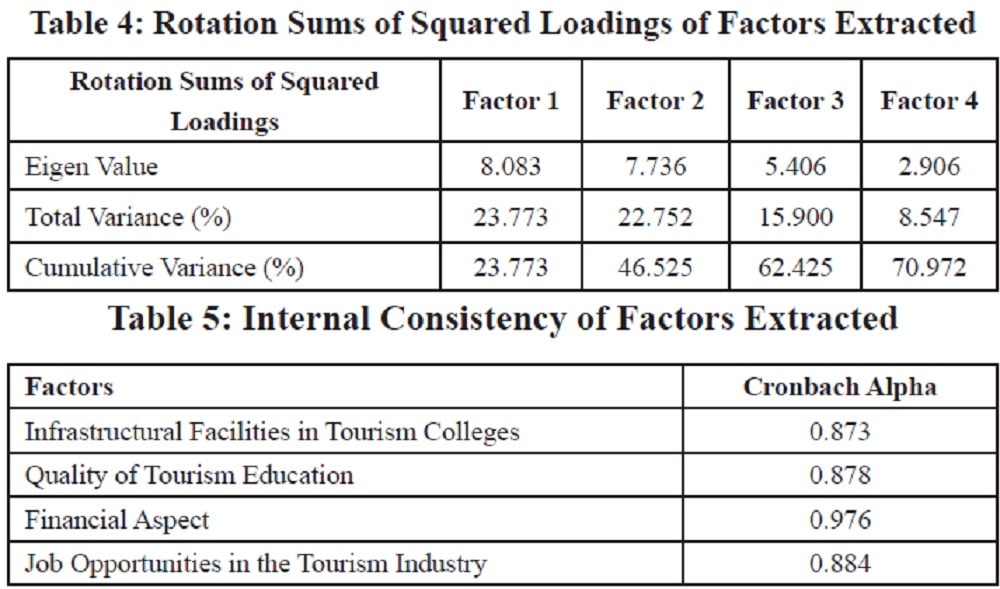
The internal consistency of the four factors has been measured thorough the Reliability test and Cronbach Alpha for all the four factors, and are close to 1. The model in Figure 1 has emerged from the study. From the responses of the students studying tourism courses in Dehradun, overall it can be said that there are total four dimensions or factors which contributes to the tourism education namely; infrastructural facilities, quality of tourism education, financial aspect of tourism education and job opportunities in the tourism industry. All these four factors affects the development of tourism education in the country.
Respondents were asked to give their opinions on the tourism education available in India. Detailed analysis of data has been given in the section below, with the help of graphs.
Graph 1 shows the % of respondents opinions that the graduate and post-graduate programs related to the tourism courses at the university level, can assist the tourism industry in India.
Interpretation: Graph 1 shows the percentage of respondents who gave their opinions about the statement that, Graduate and Post-Graduate programs related to tourism courses at the University level can assist the tourism industry in India. Thus, it can be said that the students of the tourism colleges of Dehradun strongly believe, that there should be a three years graduate and a two years post-graduate course in the stream of tourism, offered by the Universities to assist growth of the tourism industry in India.
Graph 2 shows the % of respondents opinions, that tourism education is necessary for improving the quality of tourism employees.
Interpretation: Graph 2 shows the percentage of respondents who gave their opinions about the statement that, tourism education is necessary for improving the quality of tourism employees. Thus, it can be said, that the students in the tourism colleges of Dehradun strongly believe, that tourism education is necessary for improving the quality of tourism employees. If the employees working in the tourism industry got educational degrees from the same field, they perform better as they will acquire all the necessary traits and skills during their education, which will help in service delivery .
Graph 3 shows the % of respondents opinions on the statement, that success of the tourism industry depends on the employees graduated from tourism colleges and institutes.
Interpretation: Graph 3 shows the percentage of respondents who gave their opinions about the statement, that the success of the tourism industry largely depends on the employees graduated from tourism colleges and institutes. Thus, it can be said that the students of the tourism colleges of Dehradun do not consider that the success of tourism industry largely depends on the employees graduated from tourism colleges and institutes. Rather they believe that the success of the tourism industry depends on many other factors except tourism education.
Graph 4 shows the % of respondent opinions that believe, that the tourism industry should send its employees for obtaining higher education from tourism educational institutions, to improve the quality of its personnel
Interpretation: Graph 4 shows the percentage of respondents who gave their opinions about the statement that the tourism industry should send its employees for obtaining higher education from tourism educational institutions, in order to improve the quality of its personnel. Thus, it can be said that the students of the tourism colleges of Dehradun strongly believe, that the tourism industry should send its employees for getting higher education from tourism educational institutions, in order to improve the quality of its personnel.
Graph 5 shows the % of respondent opinion, whether training of employees can increase the growth of the tourism industry and its employees.
Interpretation: Graph 5 shows the percentage of respondents who gave their opinions about the statement, that training of employees in the tourism industry can increase the growth of the industry and employees as well. Thus, it can be said that the students of the tourism colleges of Dehradun strongly believe, that training of employees in the tourism industry can increase the growth of the industry and employees as well.
Graph 6 shows the % of respondent opinions who believe, that members of the tourism industry can help in increasing the quality of tourism education by providing industrial lectures to the students.
Interpretation: Graph 6 shows the percentage of respondents who gave their opinions about the statement, that members of tourism industry can help in increasing the quality of tourism education by providing industrial lectures to the students. Thus, it can be said that the students of the tourism colleges of Dehradun strongly believe, that the members of the tourism industry can help in increasing the quality of tourism education, by providing industrial lectures to the students.
Interpretation: Graph 7 Shows The Percentage Of Respondents Who Gave Their Opinions,That There Is A Need Of Funds To Improve The Quality Of Tourism Education By The Government As Well As From The Industry.
Interpretation: Graph 7 shows the percentage of respondents who gave their opinions about the statement that, there is a need of funds to improve the quality of tourism education by the Government as well as from the industry. Thus, it can be said that the students of the tourism colleges of Dehradun strongly believe, that there is a need of funds to improve the quality of tourism education by the Government as well as from the industry.
Graph 8 shows the percentage of respondents who gave their opinion, that there is a need to allocate funds for conducting research activities in tourism education for improving the quality.
Interpretation: Graph 8 shows the percentage of respondents who gave their opinions about the statement that there is a need to allocate the funds for conducting research activities in tourism education for improving the quality. Thus, it can be said that the students of the tourism colleges of Dehradun strongly believe, that there is a need to allocate funds for conducting research activities in tourism education for improving the quality.
Graph 9 shows the percentage of respondents who gave their opinions, that there is a need of publishing special journals devoted to tourism, for increasing awareness of tourism education amongst the youth.
Interpretation: Graph 9 shows the percentage of respondents who gave their opinion about the statement that there is a need of publishing special journals devoted to tourism for increasing the awareness of tourism education amongst the youth. Thus, it can be said that the students of the tourism colleges of Dehradun strongly believe,that there is a need of publishing special journals devoted to tourism for increasing the awareness of tourism education amongst the youth.
10 shows the percentage of respondents who gave their opinion, about the subject of tourism, should be treated as a major subject instead of a minor one.
Interpretation: Graph 10 shows the percentage of respondents who gave their opinion about the statement that, tourism as a subject should be treated as a major subject instead of a minor one. Thus, it can be said that the students of the tourism colleges of Dehradun strongly believe, that tourism as a subject should be treated as a major subject instead of a minor one.
Current Scenario of Tourism Education in Dehradun
In Dehradun there are around 30 colleges that provide aviation, hospitality & tourism courses in a variety of specializations. Besides that,there are a number of small institutes that offer courses on Hotel Management and its operations.
Figure 2: Types of Tourism Courses offered by Colleges & Institutes in Dehradun
The city has more of Hotel Management courses as compared to tourism courses. PG courses are rarely found in Dehradun, and are mostly not operational due to lesser number of students. In general percentage, tourism courses are 25-30 % available dependingupon number of enrolled students. Despite being a state of such high number of tourists arrival every year, courses offered are not competent and easily available. The other courses like Disaster Management and Emergency Management in tourism are not even on the list. Tourism study in Dehradun focuses more on Hotel Management and its operations, rather than tourism as a whole.
The total number of tourism colleges and institute in Dehradun are around 30, which includes the colleges in University campus, recognized institutes and private colleges which are offering tourism education in Dehradun. The types of tourism courses provided by the tourism colleges and institutes in Dehradun are shown in the figure 2.
Figure 1 shows that the tourism education in Dehradun is provided to the students through four categories of tourism courses. Students have the option to opt for the Bachelor courses which is of three to four year tenures, Masters courses in tourism of two years tenure, Certificate courses in tourism whose tenure ranges from 3 months to 12 months, Diploma courses in tourism for one year after Graduation or Post-Graduation. Thus, the students have variety of options to pursue their tourism education, from courses offered in Dehradun.
Graph 2.2 shows the percentage of tourism colleges and institutes providing the above mentioned tourism courses in detail, under different types of courses offered.
It can be interpreted from Graph 2.2, that majority of the tourism colleges and institutes of Dehradun provide Diploma courses for tourism education, while only 9% of total tourism colleges and institutes of Dehradun are providing Masters’ degree in tourism. 27% of the total tourism colleges and institutes of Dehradun are providing Bachelors degree in tourism. Thus, it can be said that there is a need to increase the Bachelor and Masters degree courses offered in tourism colleges and institutes of Dehradun, in order to provide talented, skilled and specialized employees to the tourism industry of India.
Findings, Conclusions and Suggestions
This section focuses on the major findings of the current study, conclusions, and limitations of the study, throwing light on the the future scope of the study.
Major Findings of the Study
Following are the major findings of the study:
• It was found from the study that tourism education plays a very important role in the tourism industry.
• There are in total four important dimensions or factors which contribute to the development of tourism education in India. They are thequality of tourism education, the financial aspect, infrastructural facilities in tourism colleges and the job opportunities in the tourism industry.
• It was also revealed from the study, that students get more interest in pursuing tourism courses because they perceive good job opportunities in the tourism industry; due to the increasing growth rate of the industry Availability of sufficient number of tourism colleges and institutes, location of these colleges and institutes, and infrastructural facilities leads to an increase in the level of overall tourism education imparted
• Tourism education also get affected by the quality of tourism education, which can be defined in terms of quality of teachers in tourism colleges, number of courses, content of the courses, practical and theoretical knowledge, and skills and knowledge of the tourism educators.
• Students will be more interested in obtaining tourism education when they will have access to financial support from the institutes, and Government and education loans from the financial institutions for pursuing tourism courses.
• It was also found from the study, that students enrolled in the tourism courses have opinions that tourism education can improve the quality of employees working in the industry. If the employees working in the tourism industry obtain educational degrees from the same field, then they perform better as they will acquire all the necessary traits and skills during their education which will help them in delievering better services. The tourism industry should send their employees for obtaining higher education from tourism educational institutions overseas, in order to improve the quality of its personnel.
• The study revealed the fact that the three years Graduate and two years Post-Graduate courses in the stream of tourism offered by the Universities, can assist the growth of the tourism industry in India. The quality of tourism education can be increased, by increasing the level of knowledge and skills of tourism educators.
• It was also found from the study, that there is a need of funds to improve the quality of tourism education to be provided by the Government, as well as from the industry. There is a need to allocate funds for conducting research activities in tourism education for improving the quality of education imparted.
• Tourism education should make industrial training as a part of the syllabus to provide hands on experience to the students, and tourism education should follow a practical approach of learning rather than concentrating on a theoretical approach.
• It was also found from the study, that tourism education should be mandatory for entering into the tourism industry, as this would bring professionalism in the tourism industry.
CONCLUSION
• The educational institutes offering tourism education in Dehradun are limited and only a small number of Government institutes extend training on tourism management. Accordingly, the predominating part of qualifications for entering the tourism sector is provided at the University level.
• The absence of vocational training courses in tourism may be considered as the prime reason for the existing situation of the state’s m e a g r e share in tourism education. The introduction of vocational training courses in tourism may enhance the existing situation of the state’s tourism sector, which should be introduced in the existing Government institutes.
• One of the largest deficits is the lack of practical relevance of the educational programs, which is extremely important, due to the explicit client orientation in the tourism sector. The education and advanced training of the teaching and management staff has not been structurally developed in a continuous way, and it has not been institutionally incorporated either.
• In particular for the advanced training of the teaching staff (teachers, trainers), there is a large need for systematically structured qualification for personnel development, in alignment with the lifelong learning principle. While reviewing program courses and content, many of the programs indeed did not address these concepts and topics.
• Educators need to consider that recruiters are emphasising on softer skills such as leadership and thought based skills like strategic planning, being more important than topical technical skills.
• The question that surfaces centers on hospitality programs adjusting their curriculum, to accommodate the need for this new skill set in their programs. In Universities and colleges, most programs are conducted on a scheduled basis. In higher education, the education cycle can be as short as one year or as long as two years. Studies emphasize that most changes in curricular content of courses occurs in the instructional approach, as opposed to developing new courses.
• Tourism education must provide the tools the industry expects for students or they face the eventuality of being ignored by the industry. Going ahead in developing hospitality professionals, the certificate courses of this trade should be initiated at the intermediate level to create interest amongst the students.
The Limitations of This Study
The current study suffers from the following limitations:
• The study is based on primary data thus, there can be chances of biasness in the responses of the students.
• The sample size of the study is 100 only which is very small in comparison to the total population.
The number of tourism colleges surveyed during the current study are ten, which is again a small sample size in comparison to the total number of tourism colleges and institutes present in Dehradun.
• The study is limited only to Dehradun, it can be extended to the other cities also.
• The study is primary in nature thus, the interpretations of the data is subject tothe knowledge of the researcher and the statistical techniques or methods used.
Future Scope of the Study
The sample size of the study can be increased from 100 to larger numbers. The number of tourism colleges and institutes can be increased in the future studies conducted. The study is limited to Dehradun, thus it can be extended to other geographical areas of the country. A comparative study of Indian states can be done in the future using the same questionnaire. A comparative study of different countries can also be done related to tourism education. Furthermore, a comparative study of different tourism colleges and institutes can be done in the future. Thus, there is a large scope for future studies on the basis of this foundational research.
REFERENCES
Bagri, S.C., & Suresh Babu, A. (2009) Career in Tourism Administration, Employment News, XXXIII (46).
Bagri, S.C., & Suresh Babu, A. (2009) Critical Analysis of the Existing Scenario of Hospitality Management Education, University News, 47:36.
Bagri. S.C. (2005) ‘Human Resource Practices in Travel and Tourism Sector’, Souvenir of National Conference held in Rishikesh 19th-21st March, Uttarakhand
Bagri, S.C. (2007) ‘Tourism & Hotel Management Education in India’, in S.C. Bagri, S.K.
Gupta & R.K. Dhodi (Eds.), HRD Practices in Travel & Tourism Sector, Dehradun: Winsar Publishing House, pp153-167.
Bagri, S.C., Suresh Babu, A., & Kukreti, M. (2010) ‘Human Resource Practices in Hotels: A Study from the Tourist State of Uttarakhand’, Journal of Human Resources in Tourism and Hospitality, 9:3, pp 286-299.
Bansal, S.P. (2006) ‘Tourism Education in India: A Qualitative and Quantitative Analysis’, in D. S. Bharadwaj, K. K. Kamra and M. Chaudhary (Eds.), Tourism Education – An Emerging Essential, New Delhi: Kanishka Publishers, pp 63-84.
Bartlett, A.L., Upneja, A. & Lubetkin, M. E. (1998) ‘Benchmarking Hospitality Management Curricula: A Comparison of Top US programs’, Journal of Hospitality and Tourism Educator, 10:3, pp 41- 46.
Baum, T. (1995) Managing Human Resources in the European Hospitality Industry; a Strategic Approach, London: Chapman and Hall.
Bergsma, M. (2000) ‘The Future of Tourism and Hospitality’, Tourism and Hospitality Research, 2:2, 76-79.
Bharadwaj, D. S. (2002) ‘Manpower Development for the Tourism Sector in India, Tourism in the New Millennium, Challenges & Opportunities’, in S.P.Bansal, S. Sushama and C.
Mohan (Eds.), Cutting Edge Research in Tourism, Chandigarh: Abhishek Publications, 418-428.
Bharadwaj, D.S., Kamra, K.K., & Chaudhary, M. (2006) Tourism Education: An Emerging Essential, New Delhi, The Case of the Himalayan State of Uttarakhand, Kaniksha Publishers.
Burkart, A.J., & Medlik, S. (1974) Tourism: Past Present and Future, London, Heinemann.
Kukreti, M. (2007) ‘Determining the Responsibility for Quality HR Development in the
Tourism Sector’, in S.C. Bagri, S.K.Gupta and R.K.Dhodi (Eds.), HRD Practices in Travel & Tourism Sector, Dehradun: Winsar Publishing House, 69-85.
Sajnani, M., & Goswami, V.K. (2002) Tourism Training-Emerging Challenges, Tourism: Growth, Management and Incentives, New Delhi: Vedams Books.
Tribe, J. (1997) ‘The Indiscipline of Tourism’, Annals of Tourism Research, 24:3, 638-657
Tribe, J. (1999) ‘The Developing Curriculum’, Paper presented at the NLG Annual Conference, University of Luton, December 1st, 1999. WTTC. (2009) Travel & Tourism Economic Report (India). p.6
Avita Khawas, Assistant Professor, Chandigarh College of Hospitality, Landran, Mohali, Punjab (India). Email: avitakhawas@gmail.com.
